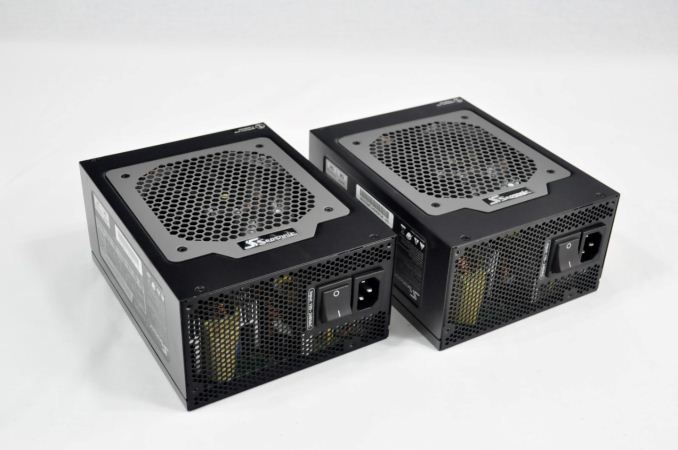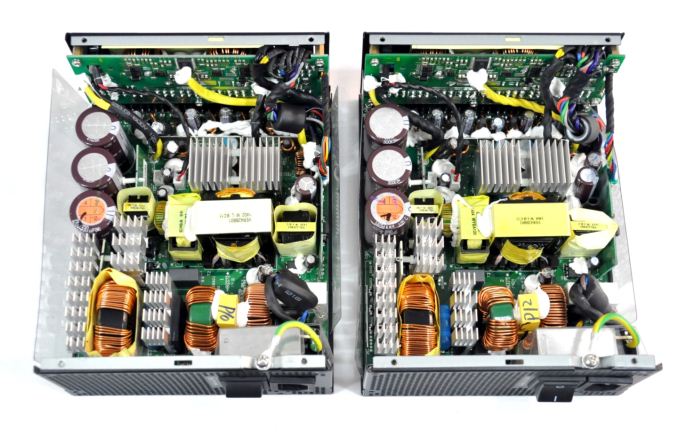Seasonic Platinum SS-1050XP3 & SS-1200XP3 Power Supply Review
by E. Fylladitakis on September 3, 2014 6:00 PM EST- Posted in
- Cases/Cooling/PSUs
- Seasonic
- 1200W
- 80Plus Platinum
- 1050W
Conclusion
Seasonic is one of the oldest PSU manufacturers and they are a very experienced company. There is no randomness about the products they design; each and every one of them serves an exact and specific purpose. This is also true for their two latest additions to the Platinum series that we have tested here today. With the power requirements of typical computers in constant decline, it is known that such powerful units have a very limited target audience.
Both of the units that we tested here today share the same external and internal design, with the only difference being the ratings of some components. Externally, the understated appearance and fully modular design will be appreciated by users. The design of the sides is a little tricky, as whether the user will be seeing a sticker with electrical specifications or decorative engravings depends on whether the PSU will be installed with the fan facing downwards or upwards.
Internally, we found an advanced full-bridge topology platform, components of the highest quality and an immaculate soldering job. The assembly job confounded us somewhat, as it is rather messy and we were surprised to see such a thing in a Seasonic product, but it should not really affect the performance or reliability of the PSUs. Besides, Seasonic covers these units with a seven year warranty, removing any concerns that we could express about the longevity of these units.
What both of the new Seasonic Platinum units really excel at is electrical performance. Both units displayed excellent energy conversion efficiency and outstanding power output quality, with the Platinum SS-1200XP3 slightly outpacing the Platinum SS-1050XP3. It appears that the more powerful components of the 1200W version give it a slight performance edge as well, despite the identical platform. They also maintain very low operating temperatures, even when heavily loaded and in adverse environments, yet at the expense of acoustic comfort. However, we do believe that very few users actually require their system to remain silent while it is heavily loaded.
The majority of the users that actually have to buy a >1kW PSU are either hardcore gamers or cryptocurrency miners. What hardcore gamers want is ample and clean power for their multi-GPU gaming system, ensuring its stability. Gamers also often seek good aesthetics, as their systems frequently include cases with windowed side panels. A gaming system requires very high power when loaded but just a small portion of it while performing simple everyday tasks. With the cooling profile that Seasonic's Platinum series has, the units will be quiet while the system is idling, discernable only when it is heavily loaded (i.e. while the gamer is actually gaming), and thus it is unlikely that any environmental noise will overcome the sound from the speakers or headphones.
Cryptocurrency miners on the other hand simply require highly efficient units that can sustain a continuous heavy load. Energy conversion efficiency is required for obvious reasons; when such a system is working 24/7, energy losses are important both financially and practically, as they cost the user money and heat up the unit, reducing its lifetime and performance. Seasonic's Platinum series units however have aggressive cooling profiles that will keep their operating temperature very low, even while the PSU is heavily loaded. Their efficiency at high loads is excellent as well, surpassing 92%. The seven year manufacturer warranty is the cherry on top for users that plan on running cryptocurrency mining rigs with these units, and likely the other components of the system will fail long before the PSU gives out. The high speed of the fan will definitely make these units loud under such conditions, but that is of little importance for cryptocurrency mining rigs.
The Seasonic Platinum SS-1050XP3 currently retails for $230 and the 1200W Platinum SS-1200XP3 can be purchased for just $20 more at the time of this review. Considering the small price difference and the slightly better performance, the 1200W version potentially offers a better value, though if the pricing gap widens, the 1050W version may become more appealing. As far as competition goes, Seasonic's new units are considerably cheaper than most of the competitive products. The Platinum SS-1200XP3 is $50 cheaper than Corsair's AXi series (e.g. $300 after rebate for the 1200W version), but it's simpler and without Corsair's Link interface. It's also cheaper than Cooler Master's V1200 Platinum ($300 as well, though it's only $252 on Amazon), with the only actual competition coming from the Leadex-based EVGA Supernova P2 1200W ($232 at the time of this review).
Ultimately, the number of use cases for 1kW and higher PSUs is rather limited. For cryptocurrency mining rigs, the good price and specific performance profile of the Seasonic Platinum units makes them an excellent choice. Of course, GPU mining has become generally unprofitable at this stage, so buying a new $200+ PSU could take the better part of a year to break even. Gamers on the other hand will have to consider other factors as they decide whether the Seasonic Platinum units can fully cover their needs or if they require the features and/or different performance profile of another model. Seasonic delivers high quality PSUs with their XP3 series, and does so at reasonable prices, so if you're in the market for such a power supply they're worth a look.












39 Comments
View All Comments
roncat - Thursday, September 4, 2014 - link
Why would you not just use a separate power supply just for the video card? Could you not just make the commons "common" for all PSU, and use the appropriate size for each application to be the most efficient. I assume the PSU outputs are fully floated. Anyone who knows why this may not work (ground loop hell, etc.), please reply.Phillip Wager - Monday, September 8, 2014 - link
this used to be an actual thing that people would do about 10 years ago when sli and crossfire just started coming out. back then everybody had full towers anyway that could house two PSUs the top one would be fore the system and drives and the bottom psu would be for your graphics card. back then 850-1000 watt power supplies were like $600 so getting two 350-500 watt power supplies was a more cost effective option. also cooler master and evga and a lot of brands made power supplies that just had 2-4 VGA eight pins coming off of it and it was marketed to gamers as video card power supplies and it was going to provide more stable power to your videocards and blah blah blah. Now the trend is to make everything SMALLER the majority of regular people who have home pcs their only home pc is actually a laptop or an all-in-one. The trend for gaming pcs is to make small game-console sized PCs and most full sized chasis these days dont even have the screw holes to fit a 2nd power supply on top of the motherboard anymore. and like i said in another post spending $70-150 to save at most 80 dollars of power over the life of the system is hardly worth the initial upfront cost especailly to deal with fitting another bulky heat source in your chasis.bebimbap - Thursday, September 4, 2014 - link
From an economical standpoint, "fixing" the lower efficiencies at almost no power draw is not worth your money. for example, and extra 15w of power 24/365 is only 131kwh most places in the us is about $.10 a kwh. why not just let it go to sleep, or shut off, most computers with ssds boot up to desktop in less than 30 seconds. But I digress, so continuing on, the inefficiency will cost you $13 more year for never using your computer. you have to subtract any time you are at non-idle state. but if you have that power supply for 8 years and not use the computer that entire time of course it adds up to $100 for keeping a computer idle 100% of the time 24/365. But if a psu was made to be 90% efficient at 10w AND 90% efficient at 1200w i guarantee you, you'd pay $200+ more per power supply for that efficiency or it'd be the size of 2 power supplies since you'd basically need 2. wasting 2x the money is also inefficient.Laststop311 - Wednesday, September 3, 2014 - link
230 is pretty expenive for the 1050 watt. I got the 80+ platinum 1000 watt seasonic for 185 45 more dollars for 50 watts is pretty crapIketh - Wednesday, September 3, 2014 - link
yea I was hoping to get a quick explanation of the differences between the 1050W and their 1000W, especially considering the price differenceIketh - Wednesday, September 3, 2014 - link
Nicely written article. The level of detail was superb.Freakie - Wednesday, September 3, 2014 - link
Dat voltage regulation though.I'm actually surprised the ripple was so high, usually Seasonic units completely beat every other unit in their class. But still, only PSU's I will put in my personal systems are Seasonic. Pretty legendary quality and performance.
SammichPG - Thursday, September 4, 2014 - link
While I understand that there's a market for this kind of unit and manifacturers send them for the halo effect, try to get some samples of low wattage units please.Most people will never go over 150-200W real world power consumption and others might be building their own nas so quality and silent power supplies in the 300W range are not only interesting but useful to a much bigger audience.
RussianSensation - Thursday, September 4, 2014 - link
Considering modern GPU's by themselves use 250-280W, and many gamers on our site use 2 of these, just in GPU power alone a solid 500W PSU is the minimum for a modern gaming rig. If all you are building is a core i3 system with no discrete GPU, then sure your system will use only 150W total.I mean really dual overclocked 780s, overclocked i7 5820K and a 1000W PSU that runs 600-700W at load keeps the system quiet.
romrunning - Thursday, September 4, 2014 - link
I think you're validating his point more than not. Today Nvidia and AMD are looking at dropping the power consumption of their GPUs, not increasing. On this site, the R9 285 was listed at 190W, and most of the R9 28x series were listed at 250W. You would have to move up to a huge card (like a Titan or R9 295x2) or dual-GPUs (SLI/Crossfire) to exceed the capabilities of a 450-550W PSU.I would say most gamers are going with the most powerful single card that they can afford, more so than dual-GPU options. Also, I think most gamers don't buy the extreme high-end, but they usually go for the one that provides the most bang-for-the-buck.
So, frankly, these reviews of high-output PSUs benefit very few. I believe more reviews of 450-550W PSUs along with looks at the power requirements of a few typical system builds a gamer might build with his own money would be more beneficial than a review of 1000W+ PSUs. Sure, do a few of them once in a while, but do more of the lower-output, more commonly-used PSUs.